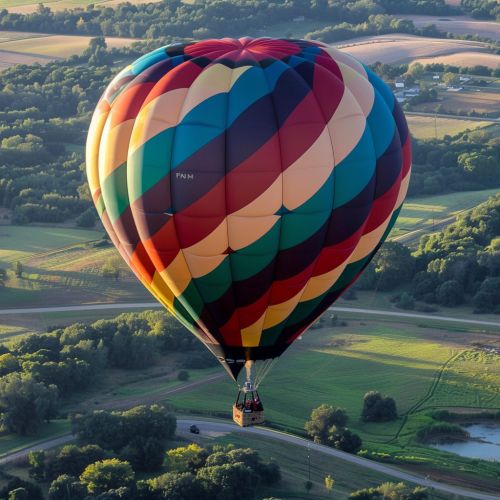Hot Air Balloons: Difference between revisions
(Created page with "== History of Hot Air Balloons == The history of hot air balloons dates back to the 18th century. The first recorded flight of a hot air balloon was conducted by the Montgolfier brothers, Joseph-Michel and Jacques-Étienne, in 1783 in France. The brothers used a combination of paper and silk to construct their balloon, which was heated by burning straw and wool. This pioneering flight covered a distance of approximately 2 kilometers and reached an altitude of around...") |
No edit summary |
||
| (One intermediate revision by the same user not shown) | |||
| Line 1: | Line 1: | ||
== | == Introduction == | ||
A hot air balloon is a type of aircraft that uses heated air to create lift. This form of aviation is one of the earliest successful human-carrying flight technologies and remains a popular recreational activity today. Hot air balloons operate on the principle of buoyancy, where heated air inside the balloon is less dense than the cooler air outside, causing the balloon to rise. | |||
The history of | == History == | ||
The history of hot air balloons dates back to the late 18th century. The first successful human flight in a hot air balloon was conducted by the Montgolfier brothers in 1783 in France. Their balloon was made of paper and silk and was heated by a fire on the ground. This historic flight marked the beginning of human aviation. | |||
[[Image:Detail-92463.jpg|thumb|center|A colorful hot air balloon in flight over a scenic landscape.|class=only_on_mobile]] | |||
[[Image:Detail-92464.jpg|thumb|center|A colorful hot air balloon in flight over a scenic landscape.|class=only_on_desktop]] | |||
== | === Early Developments === | ||
The Montgolfier brothers' success spurred further developments in ballooning. In the same year, Jacques Charles and the Robert brothers launched the first hydrogen balloon. Although hydrogen balloons became more popular for scientific and military purposes, hot air balloons continued to evolve. | |||
=== 19th and 20th Centuries === | |||
Throughout the 19th century, hot air balloons were primarily used for [[aerial reconnaissance]] and scientific experiments. The advent of the [[gas balloon]] and later the [[airship]] overshadowed hot air balloons for a time. However, the development of modern materials and propane burners in the mid-20th century led to a resurgence in hot air ballooning as a recreational activity. | |||
== Design and Components == | |||
A hot air balloon consists of three main components: the envelope, the burner, and the basket. | |||
=== Envelope === | === Envelope === | ||
The envelope is the large fabric bag that holds the heated air. It is typically made from lightweight, heat-resistant materials such as nylon or polyester. The envelope's shape can vary, but the most common design is the [[teardrop shape]]. | |||
The envelope is the large fabric bag that holds the heated air. | |||
=== Burner === | === Burner === | ||
The burner is the device that heats the air inside the envelope. Modern burners use propane gas to produce a flame that can reach temperatures of up to 2,000 degrees Fahrenheit. The burner is controlled by the pilot to regulate the balloon's altitude. | |||
The burner is the device that heats the air inside the envelope. | |||
=== Basket === | === Basket === | ||
The basket, also known as the gondola, is where the pilot and passengers stand during flight. Baskets are usually made of wicker or aluminum and are designed to be lightweight yet sturdy. They are attached to the envelope by a series of cables and ropes. | |||
== Principles of Flight == | |||
Hot air balloons operate on the principle of buoyancy, which is governed by [[Archimedes' principle]]. When the air inside the envelope is heated, it becomes less dense than the cooler air outside, creating lift. The pilot can control the altitude by adjusting the temperature of the air inside the envelope. | |||
== | |||
=== Buoyancy === | === Buoyancy === | ||
The buoyant force acting on the balloon is equal to the weight of the displaced air. By heating the air inside the envelope, the pilot decreases its density, causing the balloon to rise. Conversely, allowing the air to cool will cause the balloon to descend. | |||
=== Navigation === | |||
Hot air balloons are primarily controlled vertically. Horizontal movement is influenced by the wind. Pilots can navigate by ascending or descending to find wind currents moving in the desired direction. This requires a thorough understanding of [[meteorology]] and wind patterns. | |||
== | |||
== Safety and Regulations == | |||
Safety is a paramount concern in hot air ballooning. Regulations vary by country, but most require pilots to be licensed and balloons to be regularly inspected. | |||
=== | === Pilot Certification === | ||
In many countries, obtaining a hot air balloon pilot's license involves both theoretical and practical training. Pilots must demonstrate knowledge of aviation regulations, meteorology, and balloon operation. | |||
=== Maintenance === | |||
Regular maintenance of the balloon's components is essential for safe operation. This includes inspecting the envelope for tears, checking the burner for proper function, and ensuring the basket's structural integrity. | |||
== Modern Hot Air Ballooning == | == Modern Hot Air Ballooning == | ||
Today, hot air ballooning is enjoyed by enthusiasts around the world. It is a popular activity at festivals, for sightseeing, and even for competitive sports. | |||
=== Festivals === | |||
Hot air balloon festivals are held in many countries, attracting large crowds and numerous participants. These events often feature mass ascensions, where dozens or even hundreds of balloons take to the sky simultaneously. | |||
=== | |||
=== Competitive Ballooning === | === Competitive Ballooning === | ||
Competitive hot air ballooning involves various events that test pilots' skills in navigation and control. Common competitions include [[target flying]], where pilots attempt to drop a marker as close to a target as possible, and [[long-distance flights]]. | |||
Competitive ballooning | |||
== See Also == | == See Also == | ||
* [[Montgolfier brothers]] | |||
* [[Gas balloon]] | |||
* [[Airship]] | |||
* [[Aerial reconnaissance]] | |||
* [[Meteorology]] | |||
* [[Target flying]] | |||
* [[Long-distance flights]] | |||
== Categories == | |||
[[Category:Aviation]] | [[Category:Aviation]] | ||
[[Category: | [[Category:Aircraft]] | ||
[[Category: | [[Category:Recreational activities]] | ||
Latest revision as of 10:12, 14 June 2024
Introduction
A hot air balloon is a type of aircraft that uses heated air to create lift. This form of aviation is one of the earliest successful human-carrying flight technologies and remains a popular recreational activity today. Hot air balloons operate on the principle of buoyancy, where heated air inside the balloon is less dense than the cooler air outside, causing the balloon to rise.
History
The history of hot air balloons dates back to the late 18th century. The first successful human flight in a hot air balloon was conducted by the Montgolfier brothers in 1783 in France. Their balloon was made of paper and silk and was heated by a fire on the ground. This historic flight marked the beginning of human aviation.


Early Developments
The Montgolfier brothers' success spurred further developments in ballooning. In the same year, Jacques Charles and the Robert brothers launched the first hydrogen balloon. Although hydrogen balloons became more popular for scientific and military purposes, hot air balloons continued to evolve.
19th and 20th Centuries
Throughout the 19th century, hot air balloons were primarily used for aerial reconnaissance and scientific experiments. The advent of the gas balloon and later the airship overshadowed hot air balloons for a time. However, the development of modern materials and propane burners in the mid-20th century led to a resurgence in hot air ballooning as a recreational activity.
Design and Components
A hot air balloon consists of three main components: the envelope, the burner, and the basket.
Envelope
The envelope is the large fabric bag that holds the heated air. It is typically made from lightweight, heat-resistant materials such as nylon or polyester. The envelope's shape can vary, but the most common design is the teardrop shape.
Burner
The burner is the device that heats the air inside the envelope. Modern burners use propane gas to produce a flame that can reach temperatures of up to 2,000 degrees Fahrenheit. The burner is controlled by the pilot to regulate the balloon's altitude.
Basket
The basket, also known as the gondola, is where the pilot and passengers stand during flight. Baskets are usually made of wicker or aluminum and are designed to be lightweight yet sturdy. They are attached to the envelope by a series of cables and ropes.
Principles of Flight
Hot air balloons operate on the principle of buoyancy, which is governed by Archimedes' principle. When the air inside the envelope is heated, it becomes less dense than the cooler air outside, creating lift. The pilot can control the altitude by adjusting the temperature of the air inside the envelope.
Buoyancy
The buoyant force acting on the balloon is equal to the weight of the displaced air. By heating the air inside the envelope, the pilot decreases its density, causing the balloon to rise. Conversely, allowing the air to cool will cause the balloon to descend.
Hot air balloons are primarily controlled vertically. Horizontal movement is influenced by the wind. Pilots can navigate by ascending or descending to find wind currents moving in the desired direction. This requires a thorough understanding of meteorology and wind patterns.
Safety and Regulations
Safety is a paramount concern in hot air ballooning. Regulations vary by country, but most require pilots to be licensed and balloons to be regularly inspected.
Pilot Certification
In many countries, obtaining a hot air balloon pilot's license involves both theoretical and practical training. Pilots must demonstrate knowledge of aviation regulations, meteorology, and balloon operation.
Maintenance
Regular maintenance of the balloon's components is essential for safe operation. This includes inspecting the envelope for tears, checking the burner for proper function, and ensuring the basket's structural integrity.
Modern Hot Air Ballooning
Today, hot air ballooning is enjoyed by enthusiasts around the world. It is a popular activity at festivals, for sightseeing, and even for competitive sports.
Festivals
Hot air balloon festivals are held in many countries, attracting large crowds and numerous participants. These events often feature mass ascensions, where dozens or even hundreds of balloons take to the sky simultaneously.
Competitive Ballooning
Competitive hot air ballooning involves various events that test pilots' skills in navigation and control. Common competitions include target flying, where pilots attempt to drop a marker as close to a target as possible, and long-distance flights.
See Also
- Montgolfier brothers
- Gas balloon
- Airship
- Aerial reconnaissance
- Meteorology
- Target flying
- Long-distance flights
